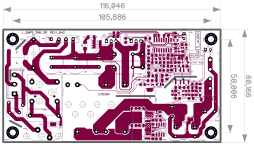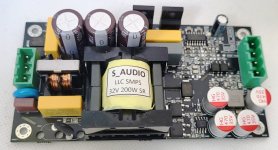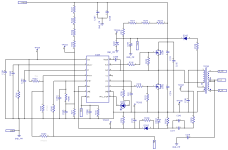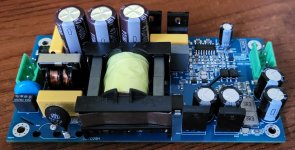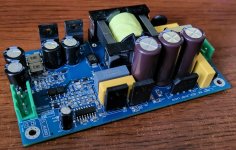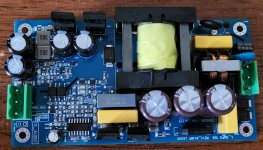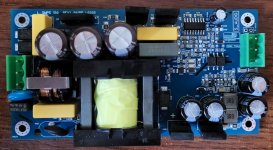Needed an inexpensive 32V power supply for audio. Chinese ones are almost all with some problems. Either the modes are poorly tuned and the noise is too high, or the burst mode works up to 20-30W. And the quality of components is also desirable.
Anyway, I decided to make my own power supply. Burst is not used. Used L6699 driver, it has improved protection circuitry and dynamic dead time, which avoids some interference problems. In addition, unlike L6599 - current protection with restart.
Added synchronous rectifier. As a result, for audio applications everything works without heatsinks. And protection indication and an external signal triggered quick unit shutdown input with trigger effect. A DC voltage protection circuit for the amplifier output can be connected here
Anyway, I decided to make my own power supply. Burst is not used. Used L6699 driver, it has improved protection circuitry and dynamic dead time, which avoids some interference problems. In addition, unlike L6599 - current protection with restart.
Added synchronous rectifier. As a result, for audio applications everything works without heatsinks. And protection indication and an external signal triggered quick unit shutdown input with trigger effect. A DC voltage protection circuit for the amplifier output can be connected here
Attachments
I also made a +/-32V bi-polar version with Schottky diodes and L6599. In general, the PCB allows to use both L6699 and L6599. Only a few elements in the protection circuit are changed
Attachments
Neat. But to me it looks like an ordinary transformer with radial windings. How do you work out the leakage inductance for the L in LLC , ie resonant series inductance? What is the operating resoannt frequency?
The transformer was made in the factory, using 6mm wide rubber tape to set the barrier between the windings. I wanted to use a sectional frame, but the manufacturer did not have any. As a result, Ls turned out to be a bit higher than calculated, Fres 90kHz approximately.
Great work as always. One comment regarding the layout, the transformer pins appear too close to the PCB edge. I generally prefer to avoid having either the primary or secondary windings near the board edges. (keep the HV core 180 with the PCB)
Additionally, it would be great to see more isolated MCU communication, ideally with EEPROM recall, to support real-time monitoring and diagnostics. (isolated communication course)
Additionally, it would be great to see more isolated MCU communication, ideally with EEPROM recall, to support real-time monitoring and diagnostics. (isolated communication course)
